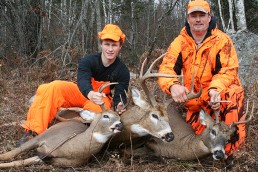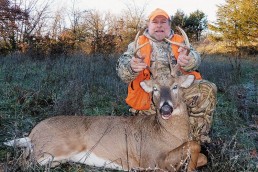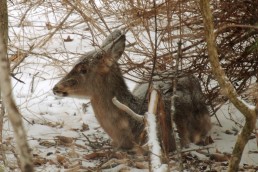Did You Get That Big Buck?
SHARE THIS POST
Slightly less than 50 percent of all the stand sites where mature bucks were taken by my hunting partners and I since 1990 were selected because they were near fresh tracks made by these bucks. The other 50 percent were selected because they were near fresh droppings made by the deer. Many of these sites were selected because these signs revealed locations or trails used by these bucks today and likely for the next morning. Not many deer hunters make use of the fresh tracks and droppings of mature bucks like we do.
This might be why you did not take that mature buck you were determined to take this year.
There are other likely reasons. For one, not all fresh deer tracks have great hunting value. If your buck was moving fast—trotting or bounding with its tail erect—it was doubtful you’d see that buck in the same vicinity during the following four days or so, perhaps not even during the remaining balance of the hunting season. A fast-moving whitetail with its tail up is a highly alarmed deer; it may have discovered a human hunting nearby. Maybe it was you. This is likely if you were moving downwind toward your stand site.
A mature whitetail’s memory may have been the problem. Contrary to common belief, whitetails do have great memories. This has been proven to me countless times since 1970. Once an adult deer (not as true with fawns and yearlings) gets a good look at you and the way you walk, it smells your unique airborne or trail scents, hears the sounds you make and discovers the trails and stand sites you favor while hunting—it will never forget them from year to year. This makes you amazingly predictable to the experienced deer to identify and avoid.
By age 2 1/2, most whitetails have learned a number of ways to avoid well-remembered hunters like you during subsequent hunting seasons. This is why the tactics you used to take a big buck in the past seldom works in the same area again for the future. This is why having “one” big buck on the wall does not make a deer hunter successful, annually.
Back in October, I had just returned from my second long weekend of scouting and preparing for our November firearm-hunting season. My hunting partners and I scout a lot to make it impossible for bucks with great memories to endlessly avoid us for future hunting seasons. We’ve learned not to expect to take bucks where we took them the year before. Our most productive stand sites are almost always those that were never used before, or not used for many years. Today, we change stand sites every half-day or every day. If you hunt one-half day to one day near very fresh tracks or droppings made by a big buck but don’t see it, then it knows you are there and it is already avoiding you.
Are you enjoying this post?
You can be among the first to get the latest info on where to go, what to use and how to use it!

Before and after hunting season begins, hunters should expect changes in whitetail-range utilization. On any one day during the season—whether breeding is in progress or not—unalarmed whitetails typically utilize (feed, water, bed and avoid hunters) within only about 10 percent of their ranges. On any one day that “10 percent” will likely be long, narrow, crooked and somewhat “donut- shaped”—made up of connecting deer trails, a bedding and feeding area and a watering spot. Whereas bedding areas are unlikely to change in location. The trails used, and even feeding areas and watering sites, can change once or twice daily due to changes in wind direction, other weather conditions and recently discovered locations of hunters. The ability to recognize which “10 percent” is currently being used—where very fresh tracks and droppings are found—on a daily basis, as you might imagine, greatly improves hunting success.
Finding these very fresh deer signs can be done without ruining its hunting value, but this requires some special skills and knowledge, unknown by many today.
This is one of the most important subjects of my next and biggest, soon-to-be published book, Whitetail Hunter’s Almanac, 10 Edition. Hunting mature bucks only—especially mature wolf-country bucks—can be extremely frustrating, but regular success is not impossible, especially after making two major changes in hunting tactics: Hunting in a manner that makes it difficult for bucks to endlessly avoid you is one. Hunting in a manner that makes you very difficult for whitetails to identify is the other.
After many years of study, my hunting partners developed, and now regularly use, an improved method of stand-hunting. It regularly provides us with easy shots at unsuspecting bucks standing or slowly moving from short distances. If you have read my articles in MidWest Outdoors during the past 20-some years, you know we are regularly successful wolf-country buck hunters.
Dr. Ken Nordberg has written more than 700 magazine articles and 12 books on the habits and hunting of whitetails and black bears, including the “Whitetail Hunters Almanac” series. He also produced “Doc’s Buck and Bear Hunting School” videos. His encyclopedic website is: drnordbergondeerhunting.com.
MWO
SHARE THIS POST
Did you enjoy this post?
You can be among the first to get the latest info on where to go, what to use and how to use it!
Dr. Ken Nordberg
Based on his 55 years of field research, Dr. Ken Nordberg has written more than 800 magazine articles, 12 books on whitetails—including the famous Whitetail Hunter’s Almanac series—five books on black bear hunting and produced Buck and Bear Hunting School videos. You may peruse his encyclopedic website with whitetail hunting tips: drnordbergondeerhunting.com, his blog: drnordbergondeerhunting.wordpress.com, or social media pages.



